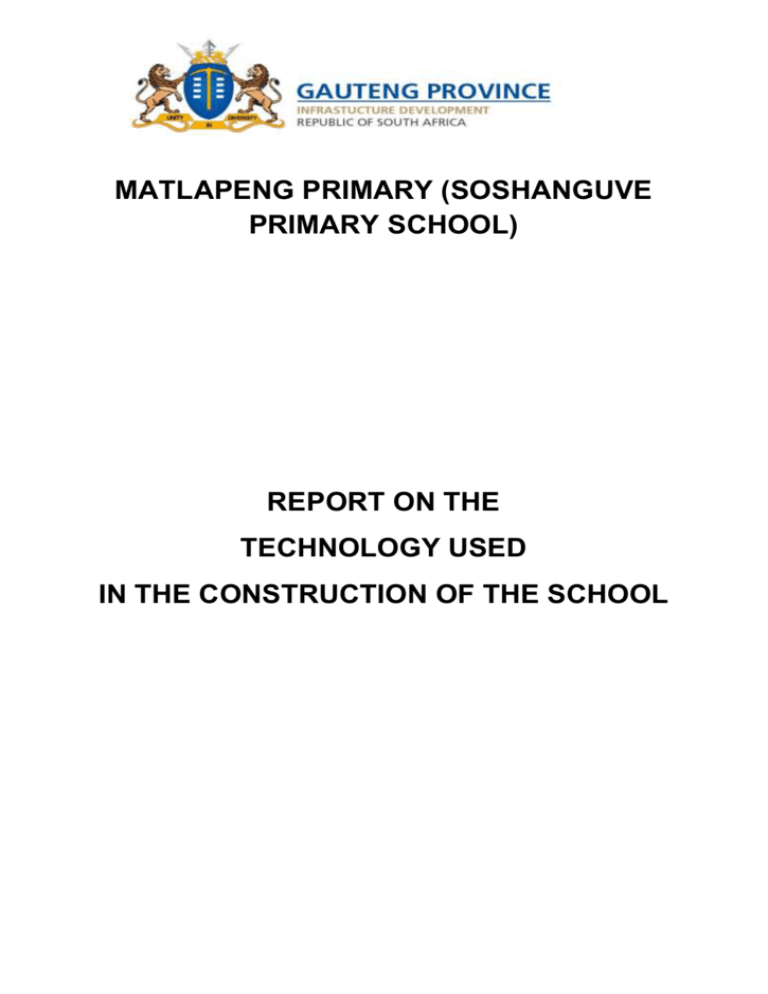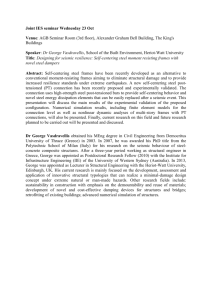Soshanguve Primary School Report
advertisement

MATLAPENG PRIMARY (SOSHANGUVE PRIMARY SCHOOL) REPORT ON THE TECHNOLOGY USED IN THE CONSTRUCTION OF THE SCHOOL 1. BACKGROUND The need to build this school was identified by the Gauteng Department of Education as a priority in 2011. The main aim was to reduce the overcrowding at existing schools and increase learner access to quality education in the area. The implementation of the Soshanguve Primary School is part of the implementation of schools using alternative construction methods (ACM). The Gauteng Department of Infrastructure entered into a tripartite agreement with the Gauteng Department of Education (GDE) and the Independent Development Trust (IDT) to implement the construction of school using ACMs. The objective of this programme was to fast track delivery of school projects using alternative construction technologies to ensure learners within the Province learn in a decent educational environment. Due to the widespread effect of climatic change, GDID, GDE and IDT took upon themselves to incorporate some elements of green buildings during and in the construction of the Soshanguve Primary School. This was undertaken to ensure the realisation of energy saving during the life of the school. In order to ensure immediate occupation and utilisation of these educational facilities, the construction process included the provision of further to the school. 2. PROJECT INFRORMATION CLIENT IMPLEMENTING AGENT IMPLEMENTING AGENT CONTRACTOR SITE HANDOVER DATE COMMENCEMENT DATE ACTUAL CONSTRUCTION COMPLETION DATE CONSTRUCTION PERIOD CONTRACT VALUE TYPE OF CONTRACT SITE LOCATION WARD GAUTENG DEPARTMENT OF EDUCATION GAUTENG DEPARTMENT OF INFRASTRUCTURE DEVELOPMENT INDEPENDENT DEVELOPMENT TRUST TRANSGARIEP INFRA (Pty) Ltd 09 MAY 2012 09 MAY 2012 02 SEPTEMBER 2013 16 MONTHS R45,635,896.42 (Incl. Professional fees) JBCC 2007 following the state clauses ERF 641; CORNER MOKHETLE STREET AND UMKHOBEZA STREET 94 3. SCOPE OF WORKS The scope of works involved the construction of a Primary School with the following facilities: An Administration block 27 Classrooms (Note that the computer room in the admin block was converted in a classroom) 3 Grade R Classrooms A Multipurpose classroom A Computer room A Library A Canteen A Guard house Sports Facility building (with change rooms, bathrooms and toilets) Soccer / Rugby ground Combination courts (netball, tennis, basketball courts) A steel palisade fence The Soshanguve Primary School was constructed using the construction methodology called the UCO solid wall system. This involves the erection of the razor build light weight steel frames structure, installation of solid boards on both sides of the steel frames and pumping light concrete between the boards. The roof trusses are also constructed from the light weight steel frames. 4. SIGNIFICANT MILESTONES The significant milestones on these projects were as follows: Site Handover date : 09 May 2012 Project Completion : 02 September 2013 5. TECHNOLOGY USED The alternative construction method used at the Soshanguve Primary School is called the UCO solid-wall system. This building system comprises of light weight steel frames that are then clad with fibre cement boards and filled with lightweight concrete mix. Fabrication of the steel superstructure is done entirely on site using locally trained labour. This system is compliant to international building standards and meets the testing requirements of SABS/SANS. This building system is Agre’ment certified, it is accredited by the NHBRC and it is a CIDB certified Industrial Building System (IBS). Materials required for the erection of wall are: Fibre cement boards Metal studs Light weight concrete 5.1 Properties of the UCO Solid wall System i. Fire Rated Up to 4 hours according to British Standard (BS 476: Part 22) ii. Lightweight Weight of walls is approximately 3 times lighter compared to brick walls. Density is 750-850 kg/m3. iii. Fast track construction Easily and rapidly constructed, cutting down construction time and cost compared to traditional wall construction. iv. High quality wall finishing Wall is straight with smooth surfaces. v. Surface finish versatility Readily accepts a wide range of surface finishes, e.g. acrylic and emulsion paint, wall paper, ceramic tiles, marble, etc. vi. Strong Anchorage capacity Conform to BS 5234 : Part 2 requirements. vii. Cleaner and safer construction Reduces messiness and thereafter easy to clean up at site. Also minimizes inconvenience to other trades compared to the labour-intensive conventional trade. viii. Impact Resistant Scuff-resistant, offering superior impact and abrasion resistance. ix. Durable Immune to permanent water damage and impervious to high humidity/moisture. Also does not warp, crack or split easily. x. Thermal insulation R value = 0.169 m2 K/W xi. Sound Insulation Sound Transmission Class (STC) rating e.g. 104mm thick wall is 46 decibels. 5.2 Comparison between UCO Solidwall system and Brickwalls DESCRIPTION BRICKWALL UCO SOLIDWALL SYSTEM Weight at 3 metre height 750kg/m or 2.5kN/m2 250kg/m or 0.833kN/m2 Productivity 4 -7 m2/man day (installation and 18 – 23 m2/man day (installation, joint plastering) treatment and skim coat) Non-combustibility (BS 476: Pt 4) Deemed to satisfy Deemed to satisfy Fire rating (BS 476: Pt 20) 120 minutes 240 minutes 6. MATERIALS USED FOR THE CONSTRUCTION OF THE SCHOOL Below are materials installed on the project. ELEMENT Sub-structure Superstructure Roofing Carpentry Ironmongery and Joinery Metalwork Plumbing and Sanitation MATERIALS Concrete; Reinforcement Light steel frames (metal studs); fibre boards, light weight concrete; nails Chromadeck roof sheets Pigeon holes, cupboards, doors Three lever locksets, indicator bolts, toilet paper roll holders Door frames, aluminum window frames PVC pipes, Wash hand basins, vandal proof water closets, copper piping, water taps 7. JOB CREATION The total number of people from the local community who worked on the project are as follows: Male : 31 Female : 51 Youth : 151 People with disability : 0 Total 233 8. GREEN INITIATIVES The following green initiatives were incorporated on the project. 8.1 Roof insulation A single layer of ‘Alucushion’ was placed directly under the roof sheeting and a 100mm layer of insulation laid on top of the battens supporting the ceiling. A total R value in excess of 3.3 is achievable. . 8.2 Glazing All glazing is 6,38 laminated safety glass which has triple the insulating R value of standard 3mm glass. It is also shatterproof and therefore much safer. 8.3 Lighting All lights were installed in accordance with Eskom’s energy saving policy by installing T5 lights which uses about half the power of the old standard fluorescent lights. Perimeter night security lighting uses energy efficient light bulbs 8.4 Light Switching The lights are controlled with a movement sensitive proximity switches attached to the ceiling of all rooms and classrooms so that when people leave the room the lights switch off automatically. An override switch was provided to be able to switch off the lights if required. Perimeter lighting is switched using day night sensors. 8.5 Solar Water Heating All hot water requirements for showers and basins are powered by solar direct geysers. Circulation pumps to these geysers are powered by Photo Voltaic (PV) solar panels mounted next to the geyser solar panels. The geysers are not connected to the Electrical system. All piping is lagged and pipe runs are limited. 8.6 Solar Photo Voltaic’ Off-Grid’ power system The school is off the municipality grid and will have electricity supply from solar energy. The solar energy system will also save the school a lot of operational cost in terms of savings on the electricity bill in future. 8.7 Mechanical Ventilation All mechanical ventilation and HVAC were not included in the project. All rooms and roof spaces are naturally ventilated. 8.8 Rainwater Harvesting System A storm water retaining structure was provided for irrigation of the sports fields in lieu of the individual grey water system tanks provided. Most of the surface storm water will flow into this retaining structure which can then be used for irrigation of the sports fields. In dry periods and/or dry seasons the retaining structure will be filled up with Council water. A complete control system has been installed in order to fill up the retaining structure during dry periods and a complete pump system has been installed to ensure that sufficient water can be pumped for irrigation purposes. 8.9 Planting Lawn and Trees Lawn and tress have been planted on the school yard. The picture below shows some of the trees that have been planted on the school. 8.10 Sewer Treatment Plant All the sewerage flows from the school will be collected at one point on the school site and will be treated and purified on site for irrigation usage. The treated and purified water will be pumped into the storm water retaining structure; and will be used with the collected storm water for irrigation of the sports field. 9. STAGES OF CONSTRUCTION (in pictures) Picture 1 below: shows the construction of the concrete slab on the raft foundation. Picture 2 below: metal studs or light weight steel frames being erected. Picture 3 below: shows fibre boards being installed Picture 4 below: shows light weight concrete mix being pumbed between the boards Picture 5 below: shows the finished school project Picture 6 below: shows solar panels for the supply of electricity Picture 7 below: shows the sewer treatment plant




![Structural Applications [Opens in New Window]](http://s3.studylib.net/store/data/006687524_1-fbd3223409586820152883579cf5f0de-300x300.png)


